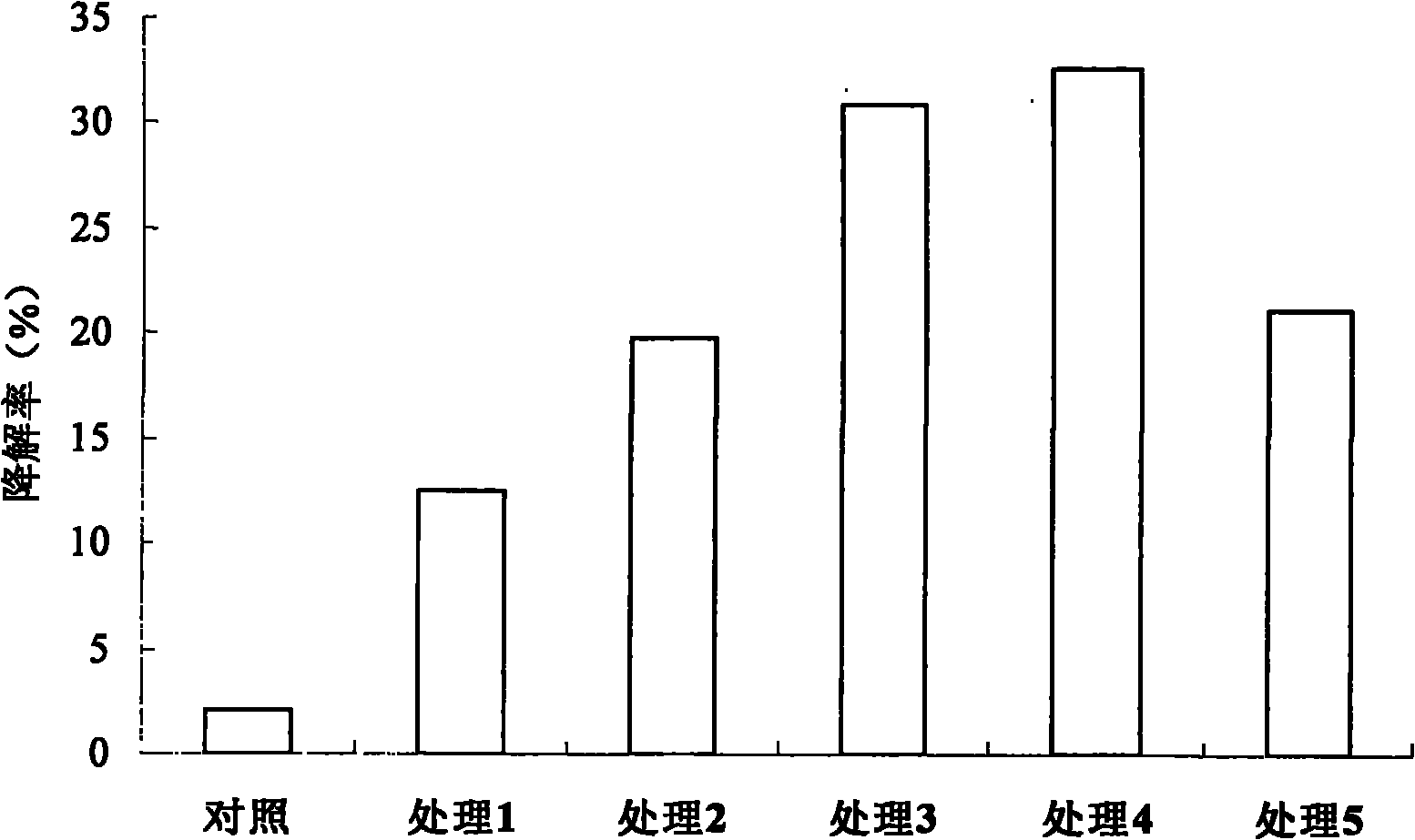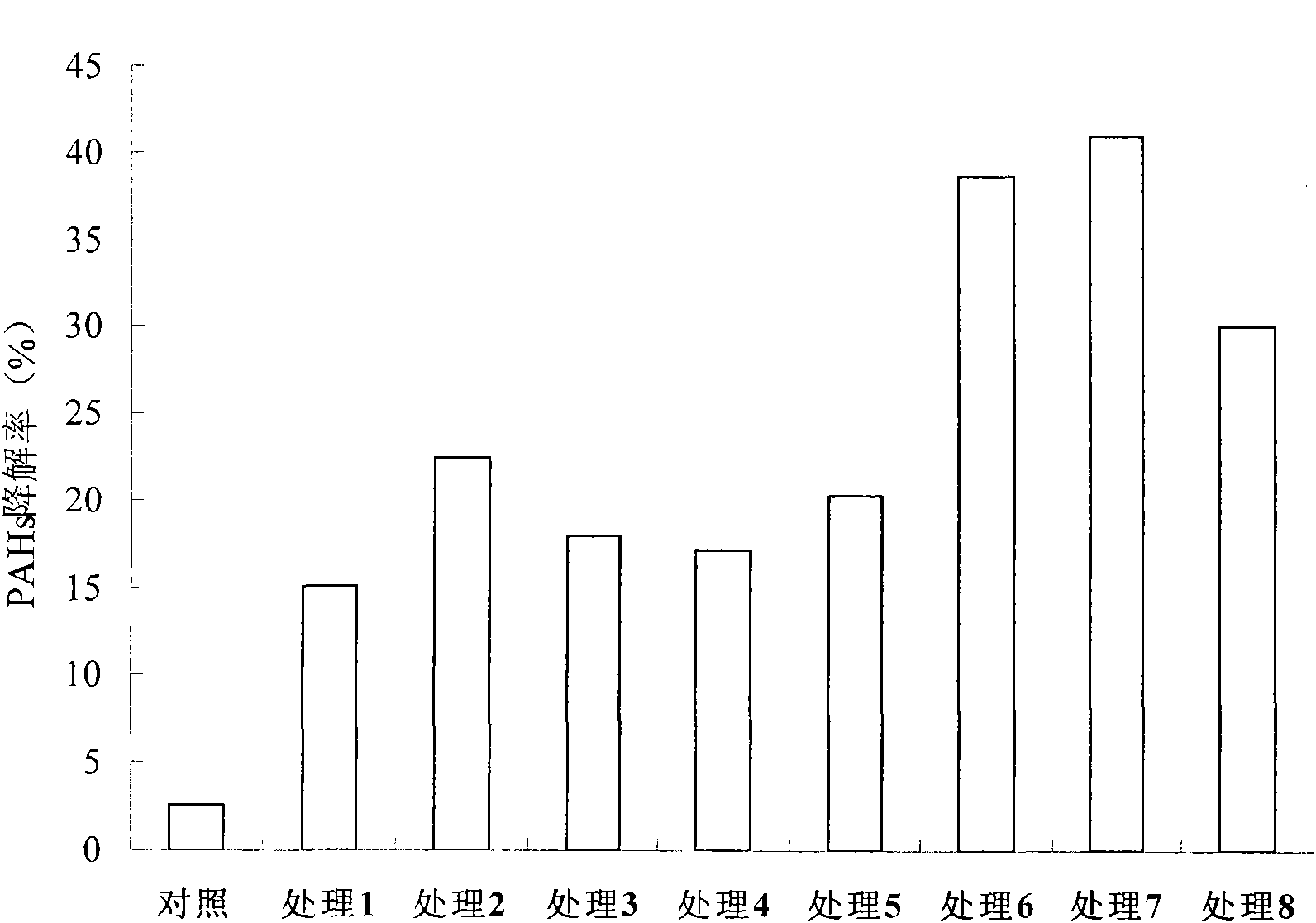Method for remediating polycyclic aromatic hydrocarbon-polluted soil by jointly enhancing plants through edible fungus residue and biosurfactant
A technology of edible fungus and biological surface, which is applied in the field of remediation of polluted environment, can solve the problems of limited efficiency and low bioavailability, so as to increase the quantity and metabolic activity, improve bioavailability and degradation rate, and improve bioavailability. Effects of Utilization and Degradability
- Summary
- Abstract
- Description
- Claims
- Application Information
AI Technical Summary
Problems solved by technology
Method used
Image
Examples
Embodiment 1
[0021] Embodiment 1: Containing the polluted soil of polycyclic aromatic hydrocarbons total amount 10.31mg / kg, alfalfa is planted in hole planting mode, planting hole spacing is 40cm, after the plant survives, manage according to the management method of common crops; wait for the plant to grow to plant height At 10cm, apply 0g, 5g, 10g and 20g of Agaricus bisporus chaff to the soil respectively. At the same time, apply 0.5L of rhamnolipid fermentation liquid with a concentration of 3g / L to the soil respectively, mix well and cover with soil about 2cm. Collect soil samples and analyze changes in the content of polycyclic aromatic hydrocarbons in the soil to evaluate the remediation effect.
[0022] After the soil is collected, pass through a 100-mesh sieve, weigh 1g of soil and add 2g of anhydrous Na 2 SO 4 , mix well, add 60ml of dichloromethane, Soxhlet extraction for 24h, evaporate to dryness with a rotary evaporator, then use 2ml of cyclohexane to fix the volume, take 0.5...
Embodiment 2
[0025] In the polluted soil containing 8.87mg / kg total amount of polycyclic aromatic hydrocarbons, alfalfa was planted by hole planting, with a planting hole spacing of 35cm. After the plants survived, they were managed according to the management methods of ordinary crops; Apply 10g of Pleurotus eryngii mushroom chaff to the soil, and at the same time, apply 0.25L, 0.5L, 0.75L and 1L of rhamnolipid fermentation broth with a concentration of 4g / L to the soil, mix well and cover with soil about 2cm, and collect the soil after 120 days of cultivation Samples were collected, and changes in the content of polycyclic aromatic hydrocarbons in the soil were analyzed to evaluate the remediation effect.
[0026] After the soil is collected, pass through a 100-mesh sieve, weigh 1g of soil and add 2g of anhydrous Na 2 SO 4 , mix well, add 60ml of dichloromethane, Soxhlet extraction for 24 hours, evaporate to dryness with a rotary evaporator, then use 2ml of cyclohexane to fix the volume...
Embodiment 3
[0029] In the polluted soil containing 13.27mg / kg total amount of polycyclic aromatic hydrocarbons, alfalfa was planted by hole planting, with a planting hole spacing of 40cm. After the plants survived, they were managed according to the management methods of ordinary crops; Apply 10g of Pleurotus ostreatus chaff to the soil. At the same time, apply 0.25L, 0.5L and 0.75L of rhamnolipid fermentation broth with a concentration of 4g / L to the soil. After mixing evenly, cover the soil with about 2cm. And the control of applying different doses of rhamnolipid fermentation broth. Soil samples were collected after 120 days of cultivation, and the changes in the content of polycyclic aromatic hydrocarbons in the soil were analyzed to evaluate the restoration effect.
[0030] After 120 days, the degradation rate data of the total amount of polycyclic aromatic hydrocarbons in soil can be seen in image 3 shown. Wherein, the degradation rate of no plant control is only 2.6%, the degrad...
PUM
| Property | Measurement | Unit |
|---|---|---|
| Diameter | aaaaa | aaaaa |
| Depth | aaaaa | aaaaa |
Abstract
Description
Claims
Application Information
 Login to View More
Login to View More - R&D
- Intellectual Property
- Life Sciences
- Materials
- Tech Scout
- Unparalleled Data Quality
- Higher Quality Content
- 60% Fewer Hallucinations
Browse by: Latest US Patents, China's latest patents, Technical Efficacy Thesaurus, Application Domain, Technology Topic, Popular Technical Reports.
© 2025 PatSnap. All rights reserved.Legal|Privacy policy|Modern Slavery Act Transparency Statement|Sitemap|About US| Contact US: help@patsnap.com



